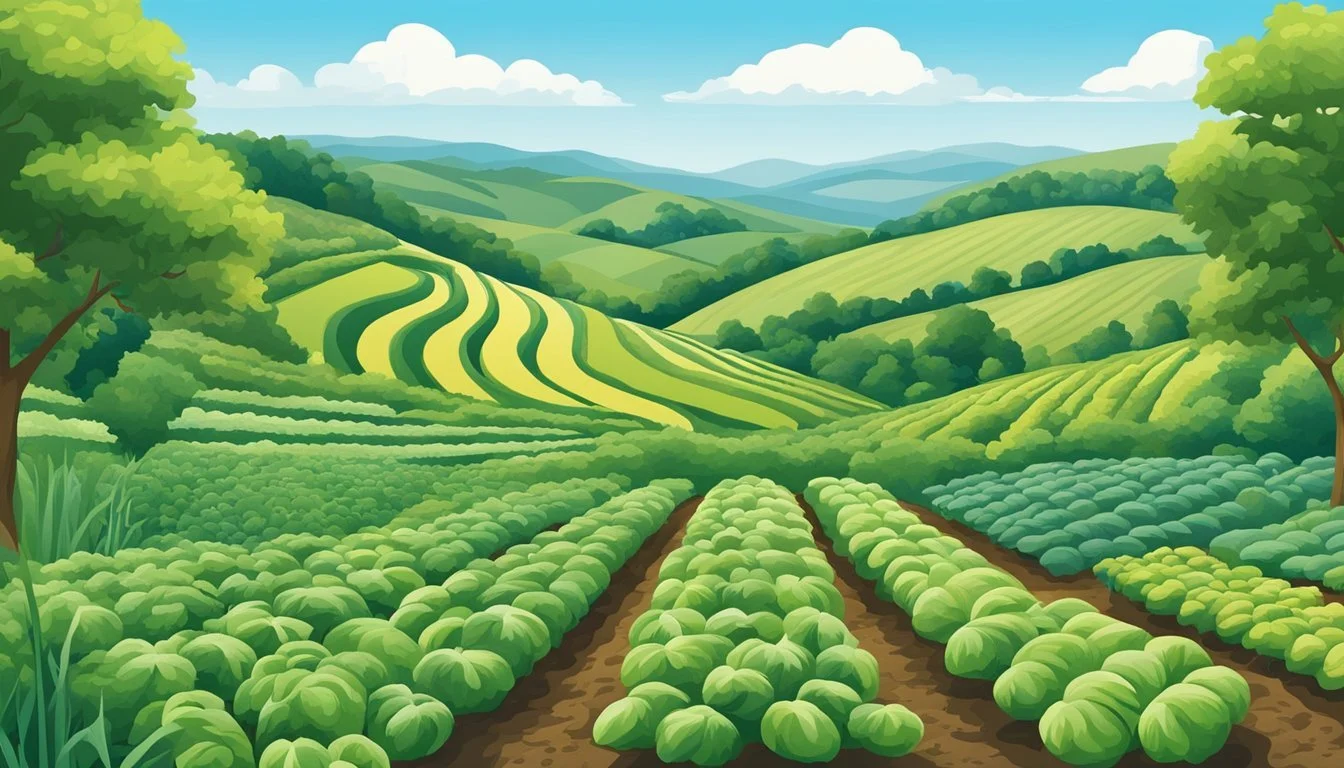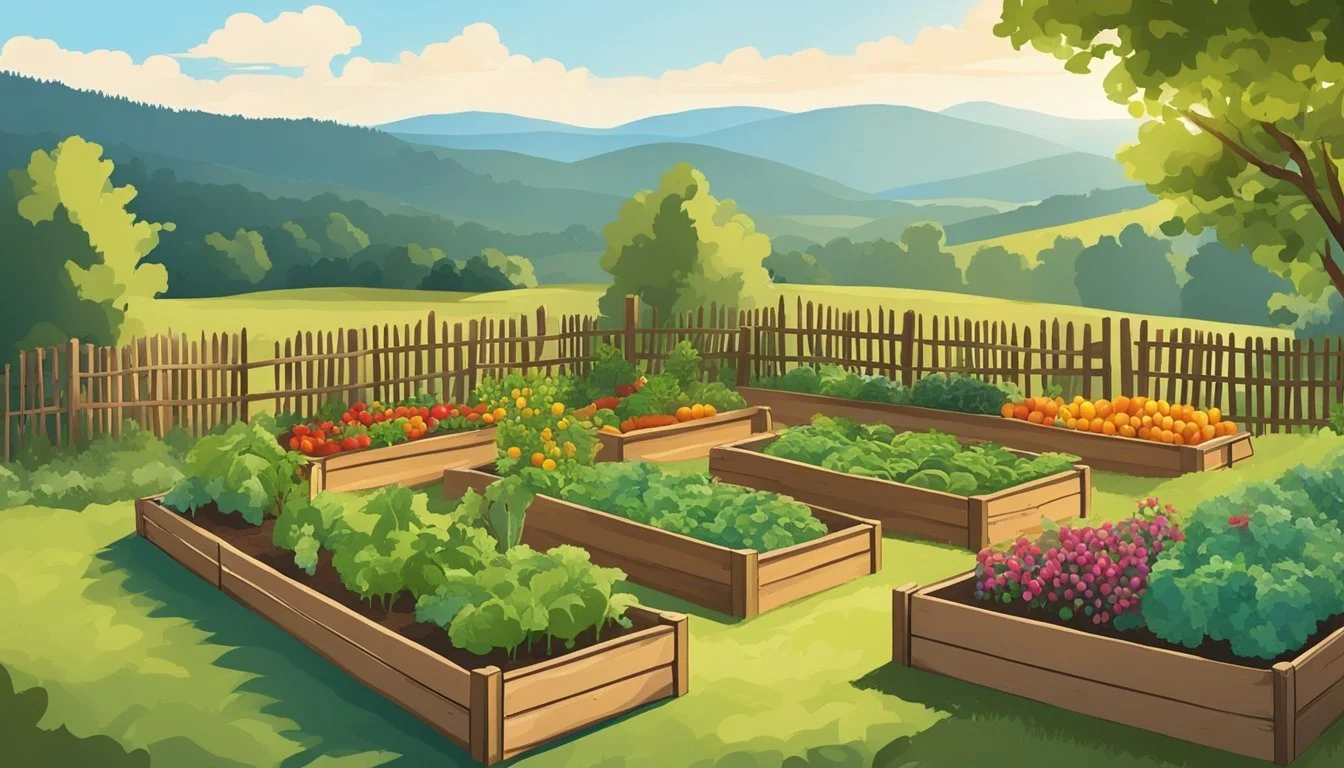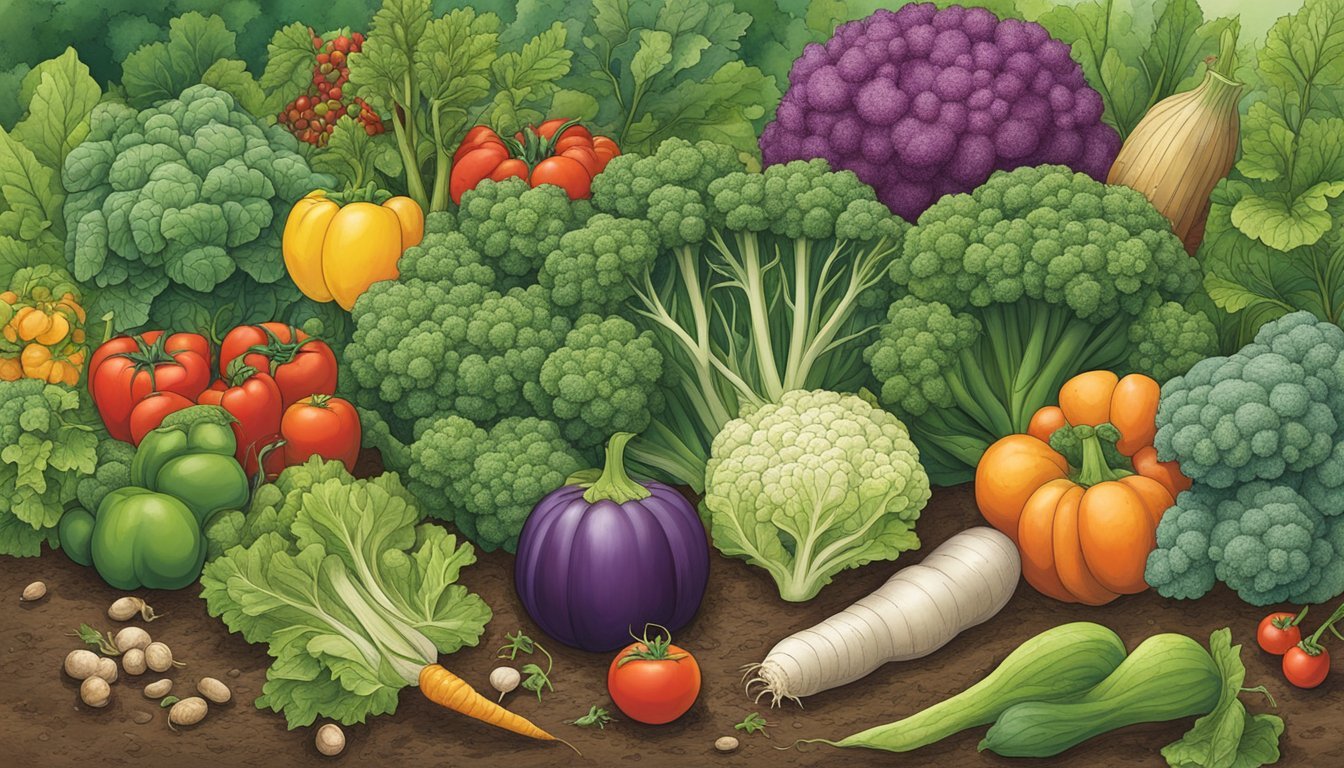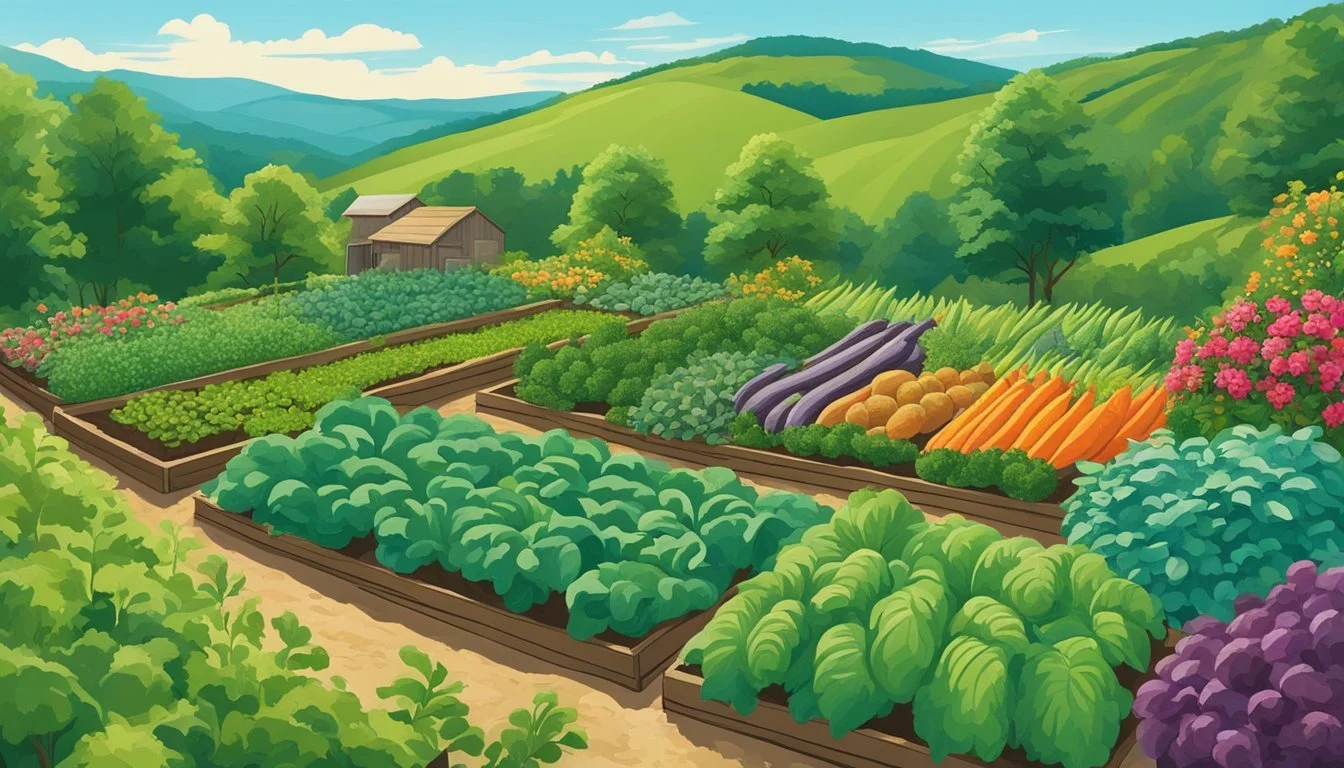Vegetable Gardening in West Virginia
A Seasonal Guide for Home Growers
This Article is Part of Our Guide on Vegetable Gardening by State
West Virginia's climate is well-suited for vegetable gardening, offering a range of temperatures that accommodate both warm and cool-season crops. With distinct seasons, gardeners can plan their planting schedules to take full advantage of the spring and fall, which are optimal times for many vegetables. The state's planting zones provide a guide for local residents to determine the best timing for planting to ensure successful growth and yield.
The landscape of West Virginia varies from mountainous regions to valleys, creating microclimates that can affect local gardening conditions. Gardeners in West Virginia can benefit from understanding their specific local climate conditions in relation to the broader zones. This attention to local weather patterns is crucial, as frost dates can impact the planting and harvesting schedule, thereby influencing the overall productivity of the vegetable garden.
To thrive in vegetable gardening, one must consider space requirements for different vegetables, as crowded plants can lead to reduced size and flavor. Whether one's garden space is expansive or limited to a small urban setting, strategic planning of crop choice and planting techniques can result in a bountiful harvest. Adequate spacing, soil preparation, and appropriate care are fundamental to growing vegetables such as radishes and eggplants, which are among the crops that have been successfully cultivated across various locations in West Virginia.
Planning Your Vegetable Garden
When starting a vegetable garden in West Virginia, understanding the local climate and planting zones is crucial. The state falls within USDA hardiness zones 5a through 7a. This range is essential for selecting appropriate vegetables that can thrive in the varying climate.
Sunlight is a key factor to consider; most vegetables require at least 10 hours of direct exposure daily. Choose a location that isn't overshadowed by buildings or trees to ensure your plants get the light they need.
Raised beds and vertical gardens offer practical benefits for garden planning. Raised beds simplify soil management and provide excellent drainage, especially in areas with clay soil. Vertical gardens are space-efficient, allowing more planting in a small area and can be particularly beneficial for climbing plants, such as beans and cucumbers.
Here is an overview of considerations for planning:
Factor Consideration Sunlight Minimum of 10 hours daily. Hardiness Zone Select plants suitable for zones 5a to 7a. Soil pH Test soil pH and adjust to match plant preferences. Watering Proximity to a water source or installation of rain barrels. Garden Type Utilize raised beds or vertical gardens as needed.
In terms of soil, the pH level can greatly affect plant growth. West Virginia gardeners should test their soil and amend it accordingly to meet the requirements of the chosen vegetables.
Gardeners also need to ensure that their garden has adequate water access. If a faucet isn't conveniently located, installing a rain barrel system can provide a sustainable water supply.
By addressing these factors, gardeners in West Virginia can plan a vegetable garden tailored to the unique regional conditions, setting the stage for a successful and bountiful harvest.
Selecting Vegetables for West Virginia Climates
In West Virginia, gardening success hinges on choosing vegetables that align with the state's distinct spring, summer, and fall weather patterns. Recognizing cool-season and warm-season crops is pivotal.
Spring and Fall Gardening
Cool-season vegetables thrive in early spring and fall when temperatures are mild. In West Virginia, gardeners can start sowing seeds for spinach, kale, and lettuce as early as April, given the typical frost-free date around April 20 to 30. These crops can withstand light frosts, allowing for an extended growing period that often transitions seamlessly into fall.
Spring: Hardy choices like peas and carrots can also be planted in early spring. They benefit from the cooler temperatures and mature before the summer heat sets in.
Fall: Broccoli and cabbage are optimal for fall, planted in late summer to mature in the cooler temperatures of autumn.
Summer Gardening
Summer in West Virginia ushers in a 160- to 180-day growing season, ideal for warm-season crops like tomatoes (What wine goes well with tomatoes?), peppers, squash, and cucumbers. These vegetables require a frost-free period and warm soil, so they are typically planted after the last frost date, which may range from April 20 to May 10 in West Virginia. Regular watering and pest control are crucial during the hot months, as these vegetables are more susceptible to stress and infestation.
Tomatoes: A summer staple, with varieties like cherry, heirloom, and beefsteak favored for their adaptability to West Virginia's climate.
Peppers: Both sweet and hot varieties perform well, including bell, jalapeno, and banana peppers, which demand warm soil and plenty of sunlight.
Cold-Hardy Varieties
Certain vegetables are distinguished by their resilience to cold and even frosty conditions. For instance, West Virginia gardeners report success with lettuce, which can endure cold springs and cooler fall months. It can withstand snow or frost and is considered low-maintenance. Other cold-hardy vegetables include:
Carrots: Can survive the cold well into fall.
Kale: Highly frost tolerant, can often produce until snow cover.
Spinach: Another robust cool-weather crop, spinach can be planted in both spring and fall.
Vegetable Planting Guide
Successful vegetable gardening in West Virginia starts with understanding the right preparations, planting techniques, and the space each plant requires.
Preparation and Timing
Preparation is essential for a thriving garden. Gardeners must select a site that receives ample sun and has well-draining soil to ensure vegetables flourish. Adding organic matter to the soil can improve its quality. The state's climate necessitates attention to timing—planting should be done after the threat of frost has passed for warm-season vegetables like tomatoes, peppers, and squash, while cool-season crops like lettuce, peas, and spinach may be planted earlier.
Cool-season vegetables: Plant as early as 2 to 4 weeks before the last frost.
Warm-season vegetables: Plant after all danger of frost has passed, often in late spring.
Planting Techniques
Different vegetables require different planting techniques. Seeds for root vegetables such as radishes, beets, and carrots should be sown directly into the prepared ground as they do not transplant well. Conversely, transplants are preferable for crops like tomatoes and peppers, ensuring a head start on the growing season.
Direct sow: Radishes, beets, potatoes.
Transplants: Tomatoes, peppers, cucumbers.
Spacing and Depth
Careful attention to spacing and the depth at which seeds are planted impacts vegetable garden success. Crowded plants compete for sunlight, water, and nutrients; proper spacing gives them adequate room to grow and reduces the risk of disease:
Vegetable Spacing Between Plants Depth of Seed or Transplant Radishes 1-2 inches ½ inch deep Potatoes 12 inches apart 3-4 inches deep Squash 18-24 inches apart ½-1 inch deep Cucumbers 36-60 inches apart ½-1 inch deep Zucchini 24-36 inches apart 1 inch deep
Mulch can be applied around vegetables to retain soil moisture and regulate soil temperature.
Garden Maintenance
Gardening in West Virginia requires attentiveness to maintenance tasks such as suitable watering, soil health, and weed control. Appropriate garden care ensures healthy vegetable growth throughout the growing season.
Watering Strategies
Vegetable beds need consistent moisture, especially during periods of drought. Gardeners should employ a watering schedule that provides 1 inch of water per week. Implementing drip irrigation or soaker hoses ensures deep watering that reaches the roots, which is essential for plants to absorb nutrients and establish a strong foundation.
Fertilization and Soil Health
Fertilization should address the primary nutrients: nitrogen (N), phosphorus (P), and potassium (K). An application of a balanced fertilizer, such as a 10-10-10 mix, contributes to overall soil fertility. Adding organic matter like composted manure can enhance the soil structure and provide a slow-releasing source of nutrients. Regular soil tests are recommended to monitor nutrient levels and pH, ensuring vegetables receive optimal growing conditions.
Weeding and Mulching
Weeds compete with vegetable plants for resources; therefore, regular weeding is necessary. Mulching with organic materials can suppress weed growth, retain soil moisture, and regulate soil temperature. Materials suitable for mulching include straw, wood chips, or shredded leaves. Besides these benefits, mulch can also break down over time, adding valuable organic matter back to the soil.
Pest and Disease Management
Managing pests and diseases is crucial for a successful vegetable garden in West Virginia. Gardeners must stay vigilant against a variety of insects and disease pressures that can impact garden health and productivity.
Common Pests
Deer: These mammals are notorious for damaging gardens. They are attracted to tender vegetable shoots and can decimate plants overnight.
Aphids: Small sap-sucking insects, aphids often cluster on new growth and the undersides of leaves. They can stunt plant growth and spread diseases.
Insects:
Tomato Hornworm: This caterpillar primarily targets tomato plants, eating the leaves and sometimes the fruit.
Cabbage Worm: Attacks members of the brassica family like broccoli and cabbage, leaving behind chewed leaves.
Plant Diseases
Plant diseases in West Virginia's vegetable gardens commonly include:
Fungal Diseases: Blight, mildew, and rust often thrive in humid conditions, causing spots on leaves and sometimes leading to plant decay.
Viral Diseases: Mosaic viruses can stunt plant growth and cause mottled patterns on leaves, which reduces photosynthesis.
Preventive Measures
Cultural Practices:
Rotate crops annually to prevent disease build-up in the soil.
Space plants properly to allow for good air circulation.
Physical Barriers:
Use fencing to deter larger pests such as deer.
Employ row covers to protect plants from insects.
Chemical Controls (as a last resort):
Insecticides: Select products specific to the pests you are targeting, such as those for controlling aphids or tomato hornworms.
Fungicides: Apply only when necessary and according to the label's instructions, especially for treating fungal diseases.
Special Gardening Techniques
In the varied climate of West Virginia, gardeners often adopt specialized techniques to maximize yield and maintain plant health. Two effective strategies are vertical gardening and companion planting, each offering distinct benefits and optimal practices for the regional environment.
Vertical Gardening
Vertical gardening is an innovative approach for gardeners with limited space. It involves cultivating plants upward using various structures, which can include trellises, nets, or stakes. This method is particularly beneficial for vegetables such as cucumbers, tomatoes, and peas, which naturally tend to climb or can be easily supported. By growing vertically, one can make efficient use of available sunlight and improve air circulation, reducing the risk of disease.
Structures used in vertical gardening:
Trellises: Ideal for vining crops like tomatoes and beans.
Nets: Useful for lighter vegetables to provide flexible support.
Stakes: Simple and effective for individual plants, such as peppers.
By implementing vertical gardening, one can significantly increase the amount of produce harvested from the same footprint.
Companion Planting
Companion planting is the strategic placement of different crops in close proximity for mutual benefit. This practice can lead to enhanced growth, attraction of beneficial insects, and natural pest control. In West Virginia, for example, planting marigolds near tomatoes can help deter nematodes, while basil can improve the flavor and growth of tomatoes.
Examples of companion planting pairs:
Tomatoes and Basil: Improves health and flavor of tomatoes.
Carrots and Onions: Onions can repel carrot flies.
Companion planting not only optimizes the vegetable garden's productivity but also promotes biodiversity and a more resilient ecosystem within the garden space.
Harvesting and Storage
When gardening in West Virginia, understanding the proper techniques for harvesting and storing vegetables ensures maximum flavor and nutrition retention. The gardener should pay close attention to ripeness indicators and handle the produce with care post-harvest.
Determining Ripeness
Tomatoes: They are ripe when they have uniform color and a slight give under gentle pressure.
Peppers: Look for firmness and the expected color for the variety, which can range from green to red or yellow when mature.
Carrots: Harvest when they reach the desired size, typically when the carrot’s shoulder pushes through the soil surface.
Beans: They are ready when they are firm and have reached their full length, but before you can see the seeds bulging.
Cucumbers: Pick when they are firm, green, and have a uniform shape.
Lettuce: Harvest in the morning when leaves are crisp and full-sized but before they start to bolt.
Post-Harvest Handling
Tomatoes: Store at room temperature away from direct sunlight to preserve flavor and prevent softening.
Peppers: Refrigerate in the crisper drawer; they can last up to two weeks.
Carrots: Remove the greens, rinse off any soil, and refrigerate in a plastic bag with some moisture.
Beans: Store in a perforated plastic bag in the refrigerator, and use within one week.
Cucumbers: Keep cool and dry in the refrigerator crisper to maintain crispness.
Lettuce: Wrap in a damp paper towel and store in a perforated plastic bag in the refrigerator crisper.
Incorporating these methods of determining ripeness and post-harvest handling will ensure the preservation of the vegetables' optimal flavor and nutritional value.
Extending the Growing Season
To maximize the yield of their gardens, West Virginia gardeners can extend the growing season by using cover crops and constructing greenhouses or cold frames. These methods can protect vegetables from early or late frosts, and boost the production of cold-sensitive plants.
Using Cover Crops
Cover crops, such as cloveer or rye, are planted to cover the soil rather than for harvest. They serve several important functions in extending the gardening season:
Temperature Regulation: Cover crops act as a blanket, keeping soil temperatures more consistent and protecting against sudden cold snaps.
Soil Protection: They prevent soil erosion and reduce the leaching of nutrients during the non-growing season.
In West Virginia, where cold temperatures can limit the growing season, cover crops are especially beneficial. They can be planted alongside cold-tolerant vegetables like cabbage, lettuce, and spinach to help these crops thrive into the colder months.
Greenhouses and Cold Frames
Implementing greenhouses or cold frames can drastically change the gardening landscape in West Virginia, allowing for a greater variety of vegetables and extending the growing season.
Greenhouses: These structures create a controlled environment, sheltering plants from the cold and pests. A greenhouse can maintain a consistent climate for year-round planting of vegetables and ornamental plants.
Advantages of a Greenhouse Provides temperature control Protects from pests and inclement weather Allows for year-round gardening
Cold Frames: Smaller and more affordable than greenhouses, cold frames offer a good solution for gardeners looking to protect specific crops from frost.
Key Points for Cold Frames:
Simple Construction: Typically made of a wooden box with a clear lid to let in light.
Microclimate Creation: Traps heat from the sun, creating a microclimate up to a few degrees warmer than the outside temperature.
By utilizing these structures, gardeners in West Virginia can start their spring planting earlier and keep their gardens producing well into fall or even winter.
Community and Educational Resources
West Virginia offers a thriving environment for vegetable gardening, supported by a robust network of community initiatives and educational services. These resources cater to the beginner gardener, ensuring they gain the necessary knowledge to start and maintain a successful garden.
Local Gardening Groups
Community gardens play a significant role in promoting vegetable gardening across the state. They not only provide space for individuals to grow produce but also become a hub for sharing knowledge and fostering community spirit. For example, Manna Meal community garden in Charleston exemplifies how volunteers can collectively harvest fresh produce. Such initiatives not only benefit the participants with fresh vegetables but also contribute to local food banks and soup kitchens, ensuring a broader impact on food security.
WVU Extension Services
The West Virginia University (WVU) Extension Services is an invaluable resource for gardeners of all levels of experience. The Extension provides accessible and research-based education on vegetable gardening tailored to West Virginia’s unique climate conditions. They offer:
Planting Guides: Illustrated guides for both warm-season and cool-season crops, considering the state's planting zones.
Workshops: Educational workshops that range from basic gardening skills to more advanced techniques.
Publications: A variety of materials such as the "West Virginia Garden Guide" and "Starting a Home Vegetable Garden" offer comprehensive advice on crop selection, soil preparation, and maintenance.
Community Support: The Extension encourages gardeners to contribute to community gardens, enhancing the sustainability of local food systems.
By participating in these groups and utilizing the services offered by the WVU Extension, beginner gardeners in West Virginia can become quite knowledgeable and contribute positively to their communities.
Advanced Topics in Vegetable Gardening
Diving into the advanced aspects of vegetable gardening in West Virginia encourages gardeners to explore beyond the basics. Discerning between different plant varieties and adopting organic practices can significantly impact the quality and sustainability of a garden.
Hybrid and Heirloom Varieties
Hybrid varieties are cultivated by cross-pollinating plants to enhance certain traits such as disease resistance or yield. In West Virginia, hybrid vegetables like cherry tomatoes and beefsteak tomatoes can be successfully grown, offering an array of options for the gardener looking for robust and high-producing plants. On the other hand, heirloom varieties have been passed down through generations and are open-pollinated. These vegetables, such as heirloom pumpkins, are often celebrated for their flavor and diversity. They can be more labor-intensive but are sought after for their unique characteristics and genetic diversity.
Hybrids:
Pros: Disease resistance, uniformity, productivity.
Cons: Generally, cannot save seeds for future use.
Heirlooms:
Pros: Unique flavors, traditional varieties, save and share seeds.
Cons: May require more careful management, can be less predictable in growth.
Organic Gardening Practices
Organic gardening practices emphasize the use of natural inputs and methods to manage pests and nourish the soil. In West Virginia, with its varying terrain and climate, gardeners who follow organic practices may choose to cultivate easy-to-grow heirloom varieties such as 'Roma' tomatoes or 'Sugar Pie' pumpkins, which typically adapt better to local conditions without the need for synthetic fertilizers and pesticides. Key components of organic gardening include composting, crop rotation, and biological pest control, which help maintain soil health and promote a balanced ecosystem.
Key Organic Practices:
Compost: Enriches soil with nutrients and beneficial microorganisms.
Crop Rotation: Minimizes pest and disease build-up, improves soil fertility.
Biological Pest Control: Encourages natural predators to manage pests.
By focusing on these advanced topics, gardeners in West Virginia can achieve a more rewarding and environmentally friendly gardening experience.
Gardening in Various West Virginia Elevations
In West Virginia, gardening approaches must be tailored to the elevation and specific climate zones. Certain areas are classified in Zone 5 or Zone 6, which affects planting times and suitable crops.
Adjustments for High Elevation
Gardening at high elevations in West Virginia, typically defined as areas above 2,000 feet, presents unique challenges. Gardeners must adjust for a shorter growing season, given that temperatures can be more variable and frost may occur later in the spring and earlier in the fall compared to lower elevations.
Frost Dates: In these areas, the frost-free date may be as late as May 10, and the first killing frost can arrive by October 5.
Growing Season: Elevations above 2,000 feet generally have a growing season ranging around 145 days.
It is imperative that individuals select plant varieties that can mature within this timeframe or use season-extending techniques such as cold frames.
Microclimate Exploitation
Microclimates can be strategically used to extend the growing season and negate some of the harsher conditions at varying elevations. These small pockets of space where the climate differs from the surrounding area can be warmer and more humid, which can be beneficial to certain crops.
Location: South-facing slopes and walls may retain heat, creating warmer microclimates.
Soil Preparation: Black plastic mulch or stone can absorb heat during the day, releasing it at night, which assists in creating a warmer microenvironment.
Vegetation: Planting windbreaks can shield sensitive crops from cold winds, also contributing to the creation of a microclimate.
Utilizing microclimates demands an understanding of the local topography and vegetation. They offer gardeners in West Virginia an opportunity to cultivate a broader variety of plants, even within the constraints imposed by higher elevations.
Conclusion
In West Virginia, the success of vegetable gardening hinges on understanding and adapting to the regional climate and soil conditions. Gardeners typically achieve the best results when they choose vegetables well-suited to the area’s unique environment. A few top picks for the state include leafy greens like lettuce, known for their cold hardiness and low maintenance, as well as Brussels sprouts, which are suitable for the cooler fall months.
The soil in West Virginia usually benefits from enhancement, with most vegetables preferring loose, fertile, and well-drained soil. Organic matter can be essential for soil improvement, and maintaining a pH range of 6 to 7 is often ideal, although many crops are quite forgiving with slightly less than perfect conditions.
Key Considerations for a Successful Vegetable Garden in West Virginia:
Site Selection: Choosing a location with good sun exposure and proper drainage.
Soil Preparation: Enhancing soil with compost to improve fertility and structure.
Crop Selection: Opting for vegetables that match the state's growing conditions, such as lettuce and brassicas.
Seasonal Planning: Planting in synchronization with West Virginia’s varied climate, utilizing cool springs and falls.
By adhering to these guidelines, novice and experienced gardeners alike can expect a thriving vegetable garden with a rewarding harvest throughout the growing season, contributing to home sustainability and the enjoyment of fresh, home-grown produce.








